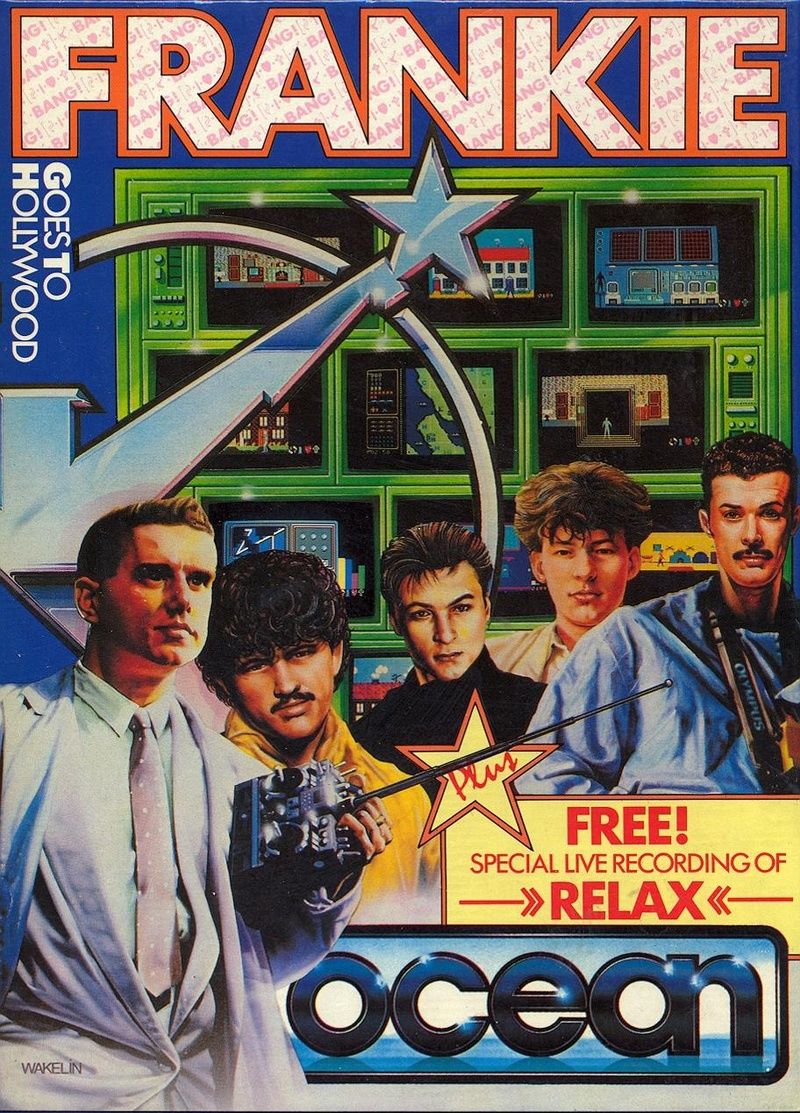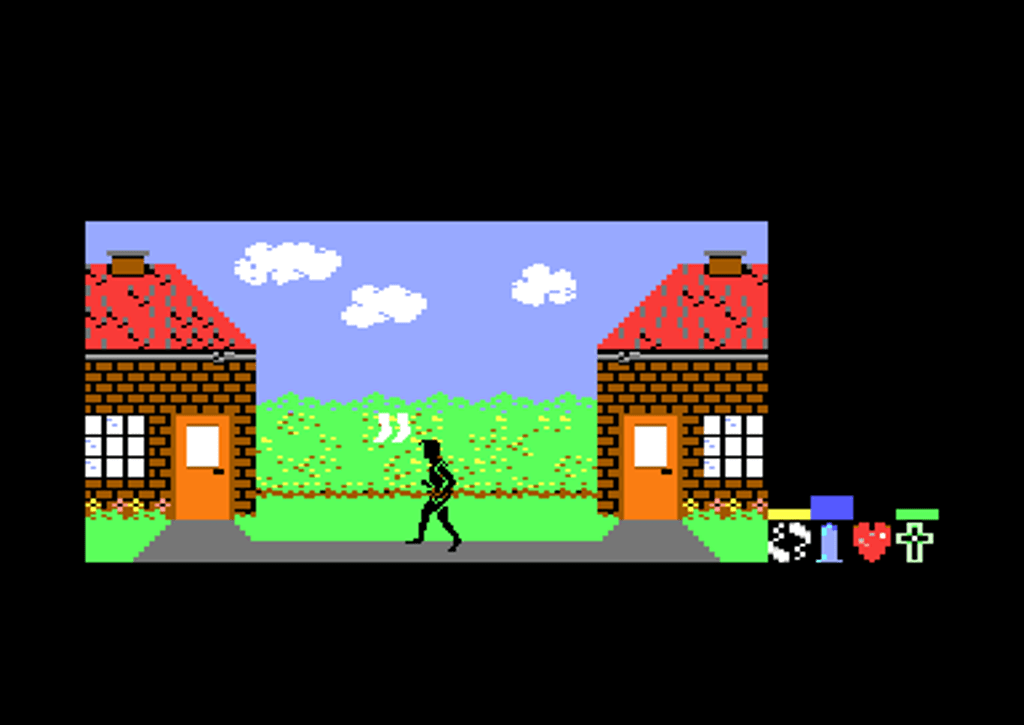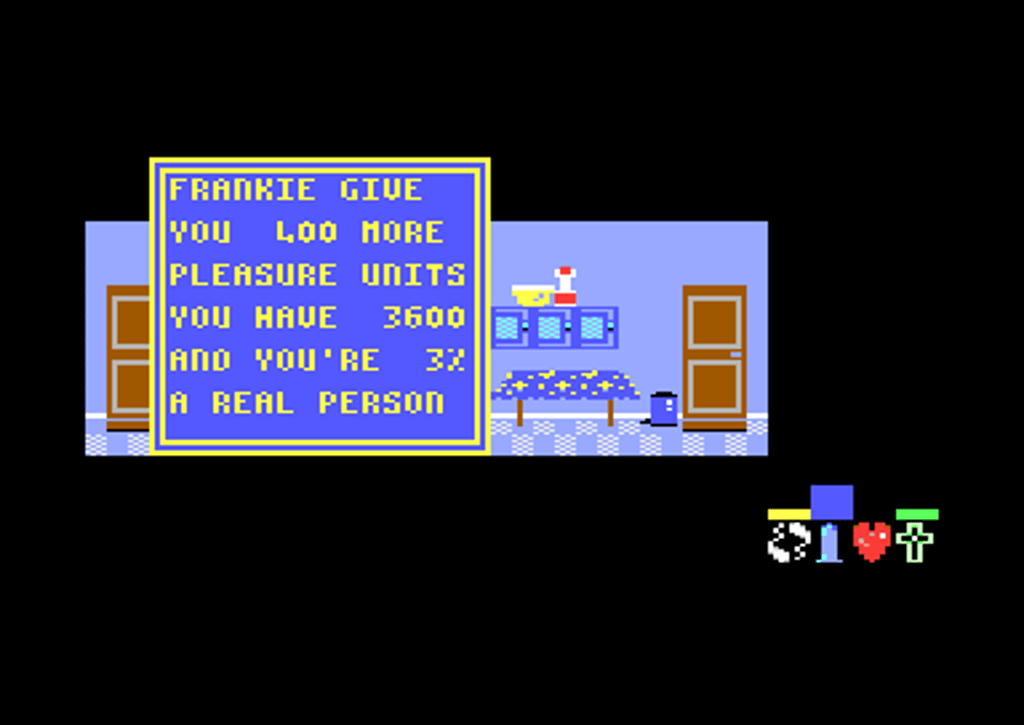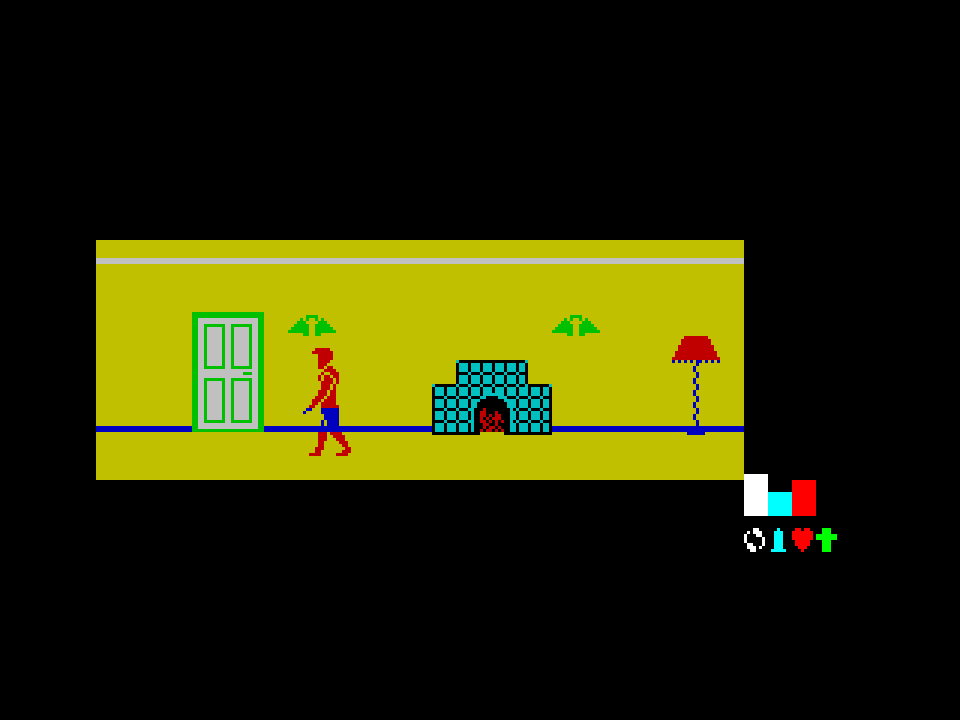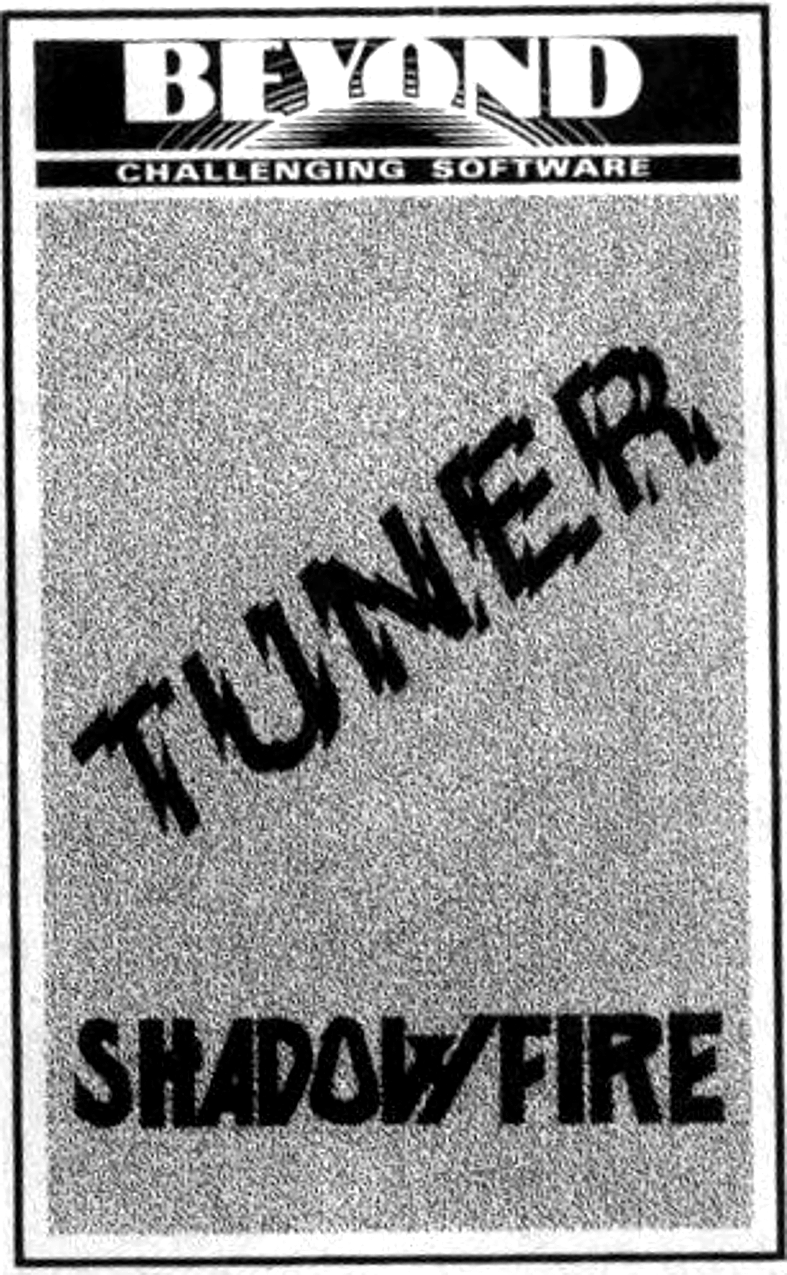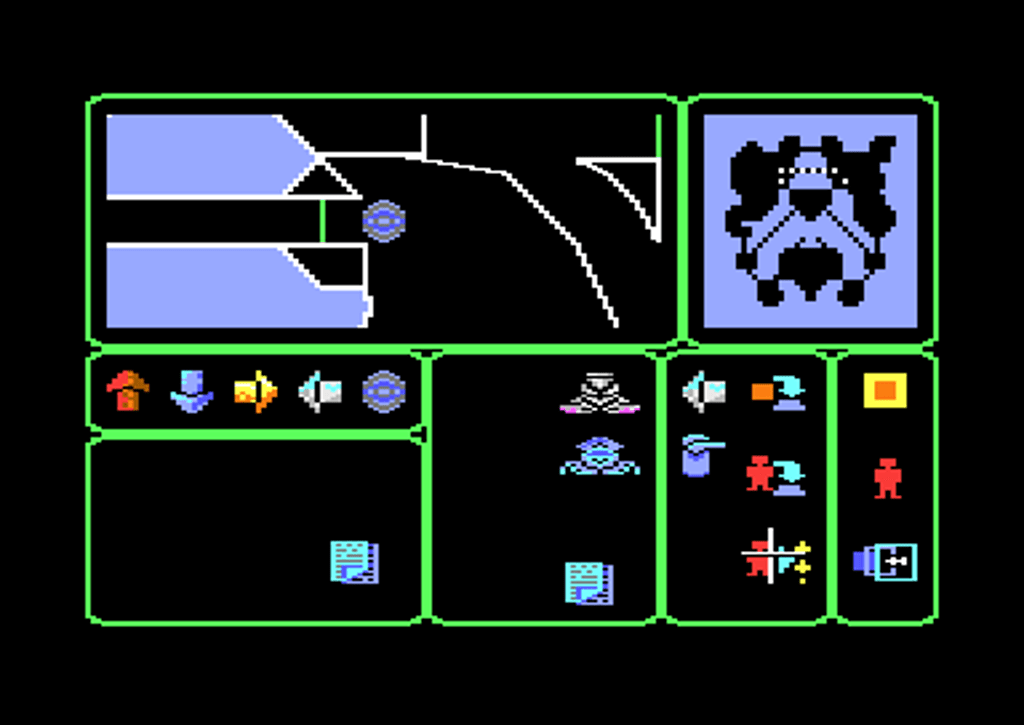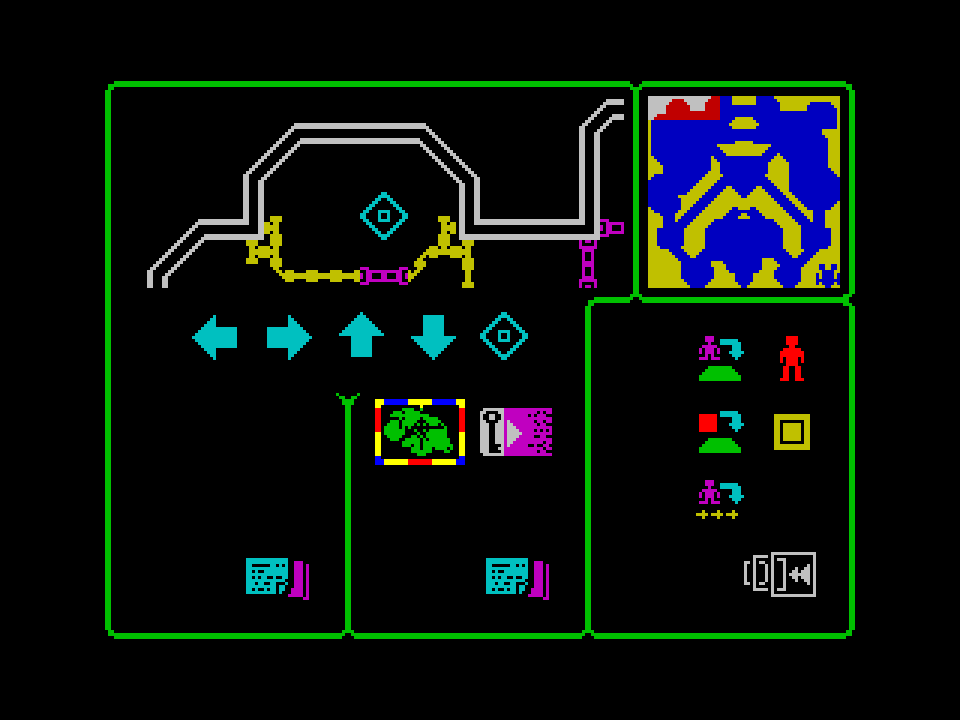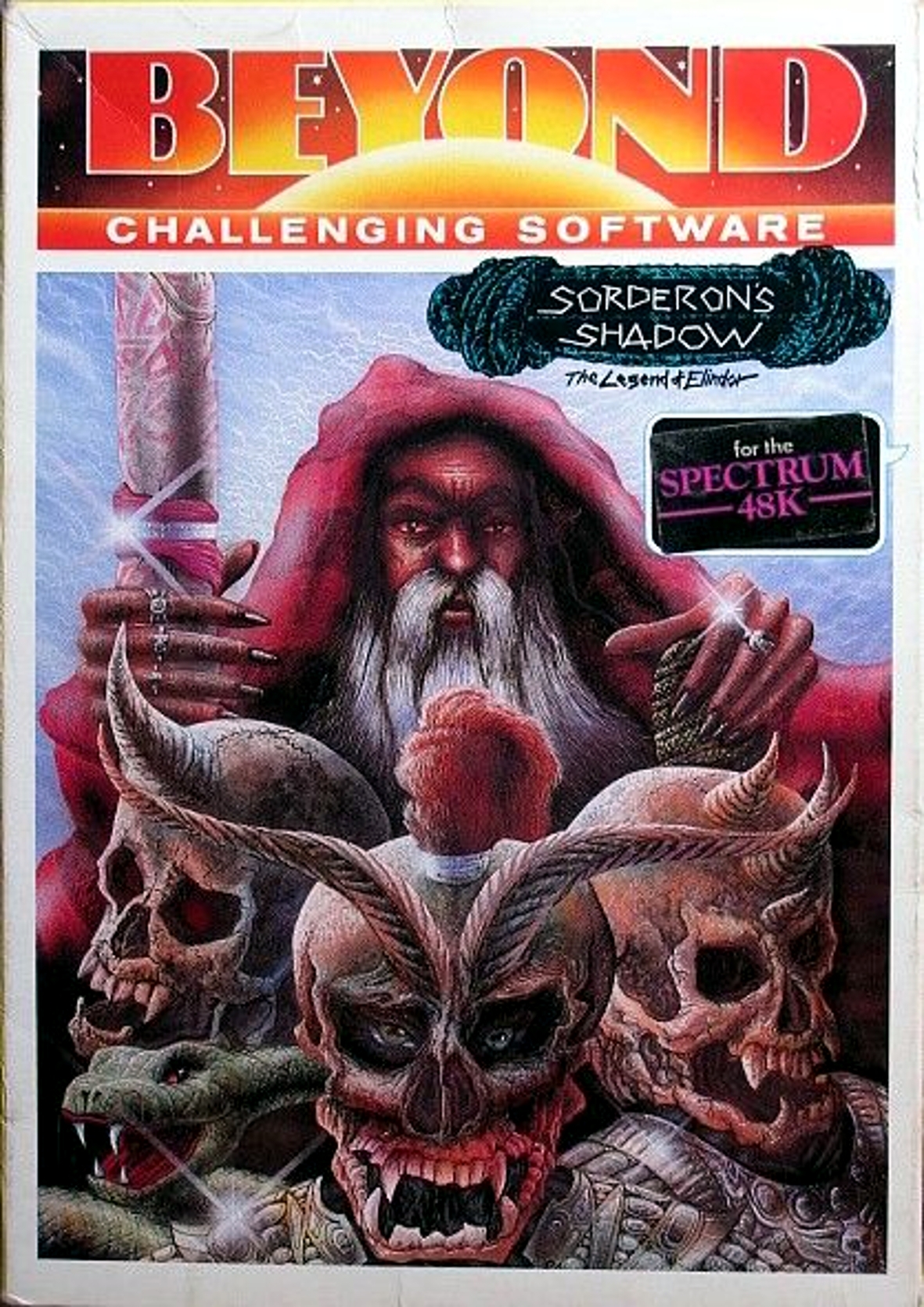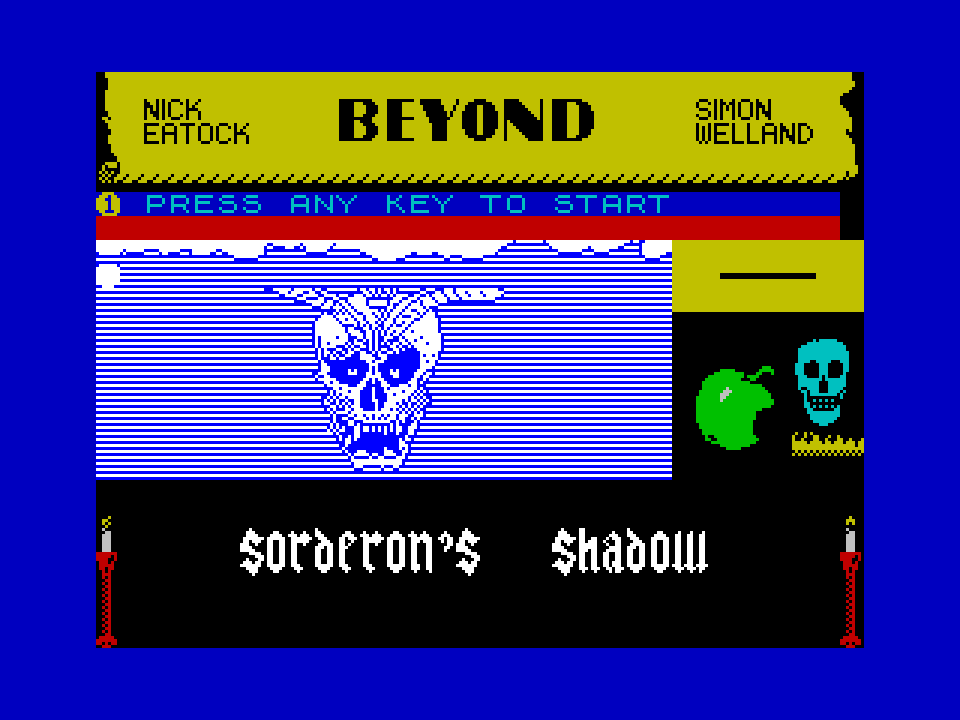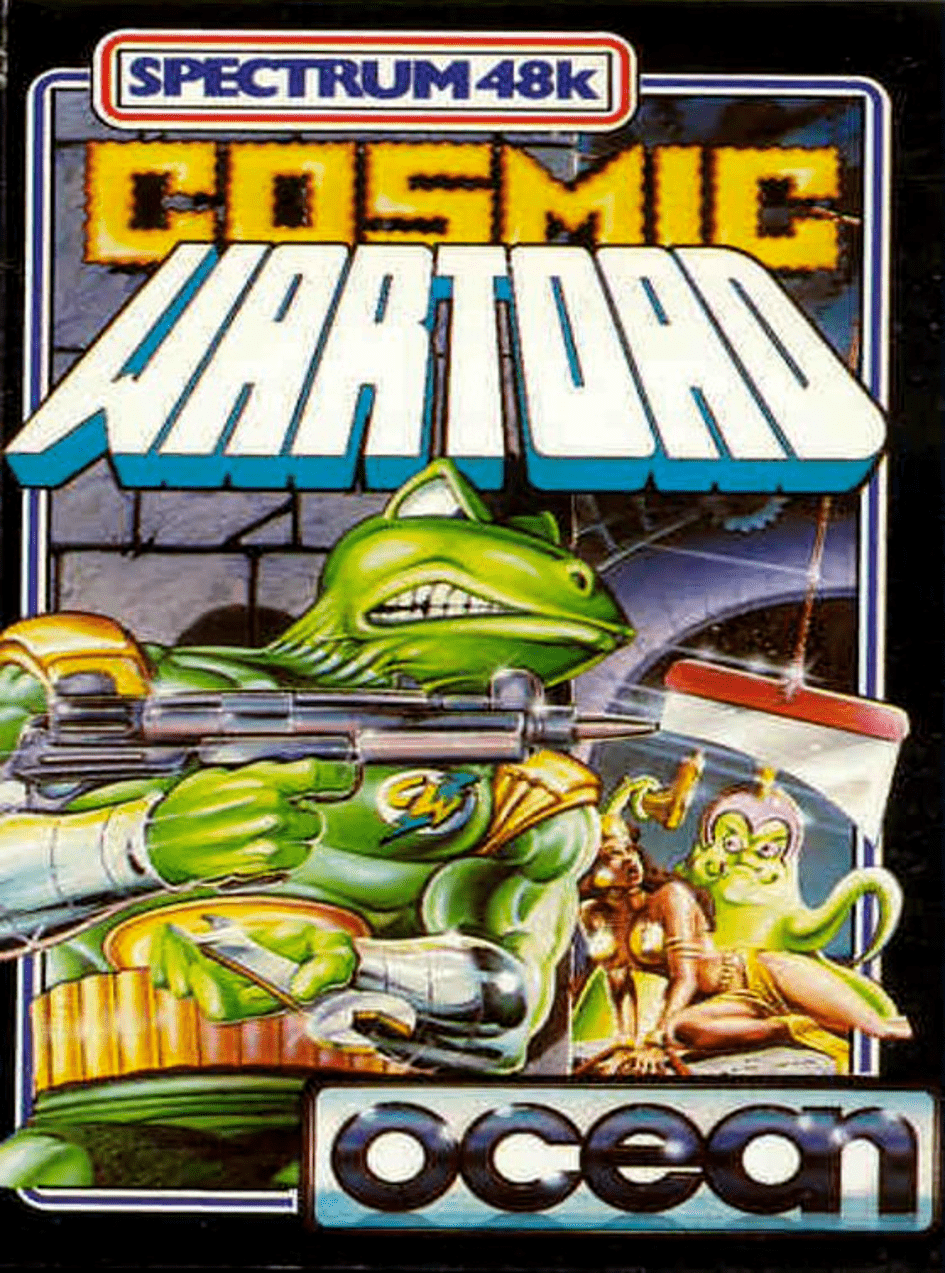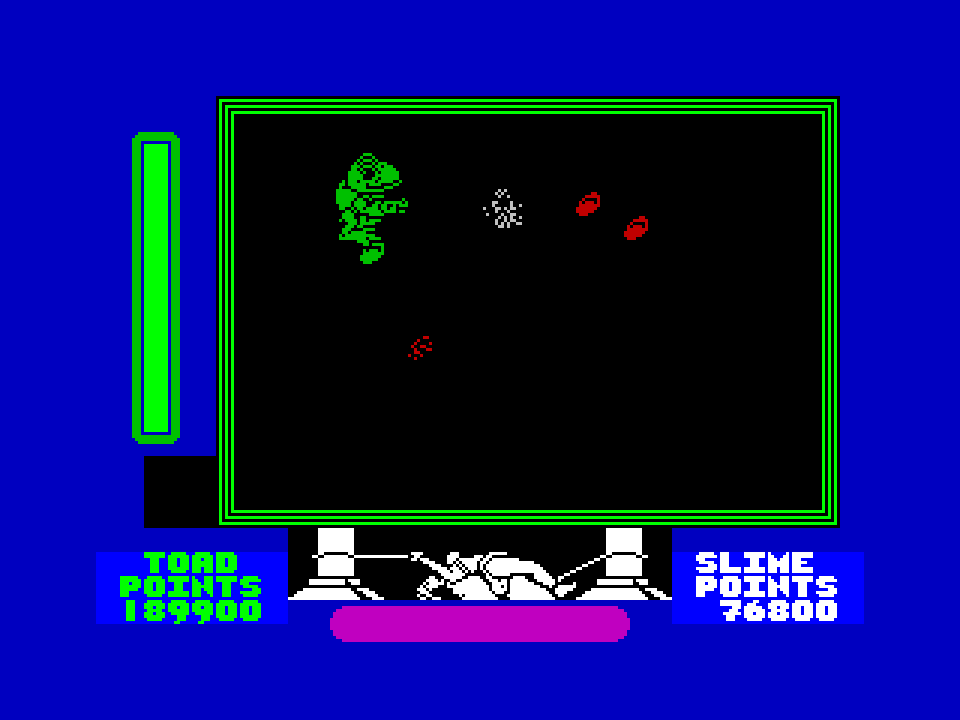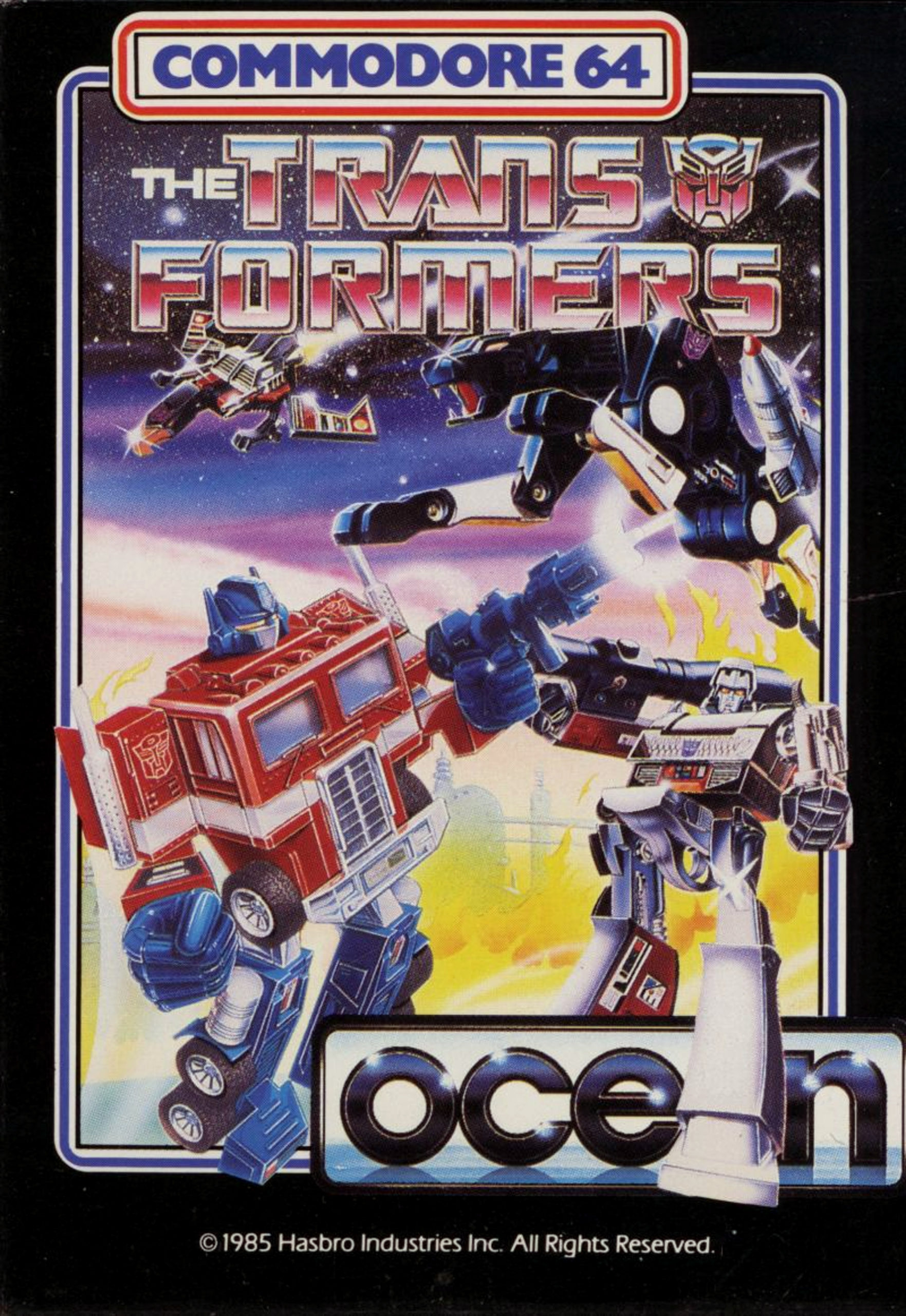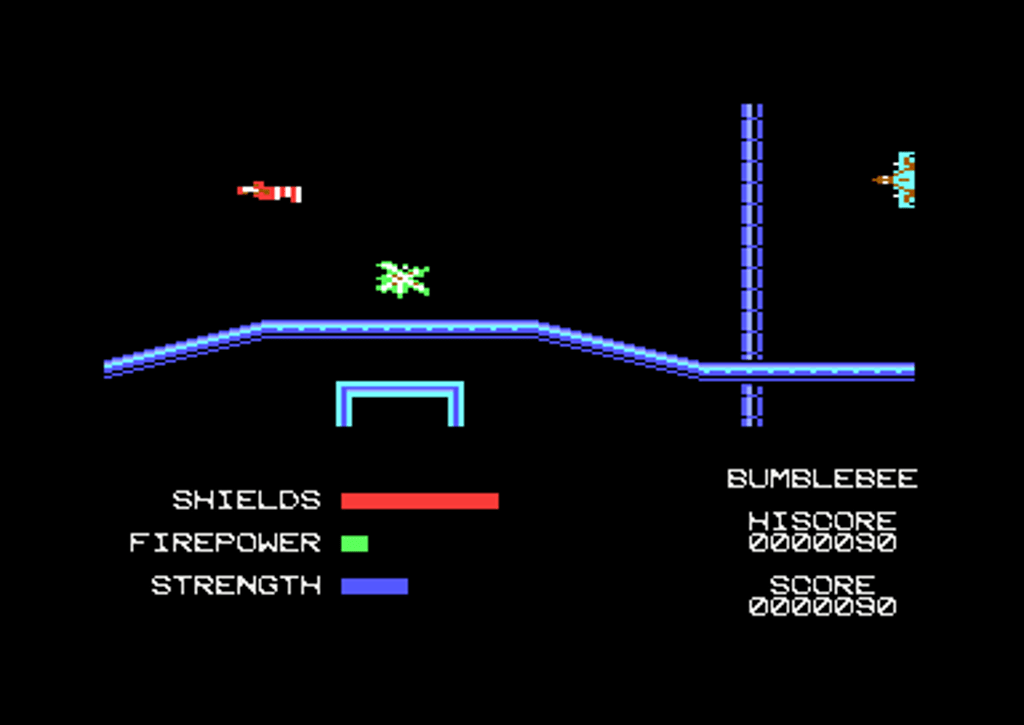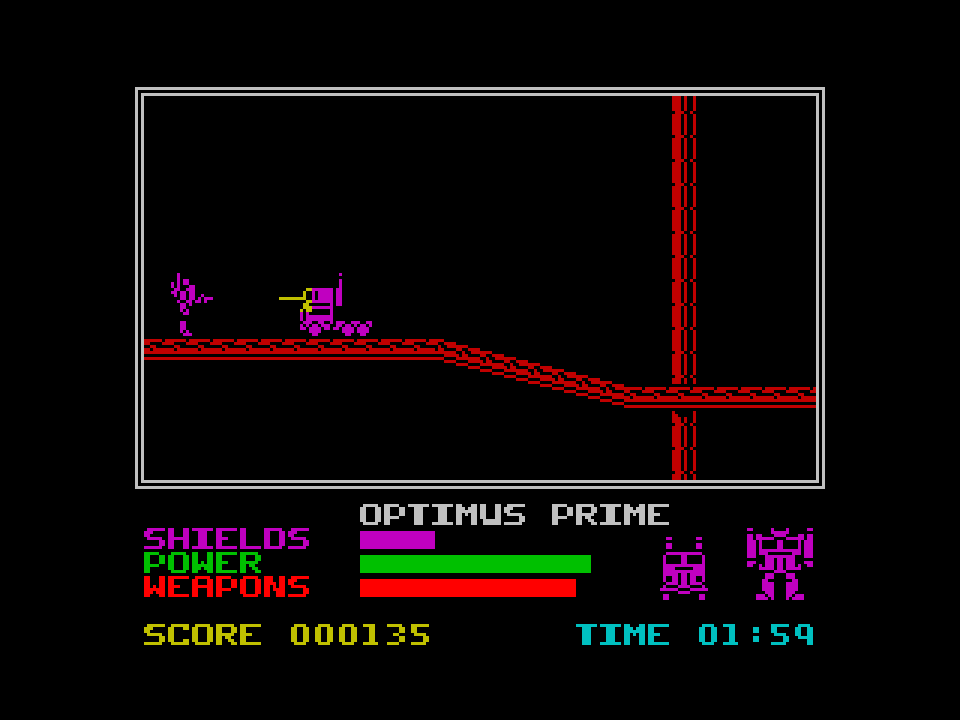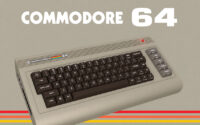Art For The Machines: Part II – Denton Goes To The Top
Frankie Goes to Hollywood (Ocean) – While this is the video game that single-handedly and properly welded Ocean to the map of software publishers and simultaneously made them a name to seriously be reckoned with in the business, there is also a big chance that you either remember or know about the 80s New Wave band and its relatively short period of releasing hits rapid fire-style – The singles Relax, Two Tribes, The Power Of Love, and Welcome To The Pleasuredome are, incredibly enough, all on the very same album – 1984 year’s Welcome To The Pleasuredome…
So how do you even create a video game based on a real band? – Especially if you don’t want to make a spiritual successor to Data Age’s Journey Escape. Well, Denton Designs elegantly avoided that swamp by thinking so far outside the box that not even the edges are in sight. In the game itself, you can only discern them at the “horizon”. (That’s a metaphor, of course.) And the horizon would be the graphical dimensions of the screen and the background graphics. Because there is an illusion, however short-lived it may be, that you have absolute freedom of movement in this world and that anything is possible. Yeah, that’s already one spaced-out simile too many, but the thing is that someone who routinely had cranked out Pac-Man- and Manic Miner-clones for a couple of years wasn’t probably going to have enough solid ideas for a game like this.
Instead, Frankie was fully designed by “four non-games-playing people” – People that prioritized ideas and the playing experience instead of being vaguely interested in cranking out yet another Coin-Op conversion that could sell a couple of copies. You don’t want to make a three year old Atari 2600-game look good. And what happened? Frankie was an amalgamation of several simultaneous takes on video games that happened to click with the player. That’s a fresh and perfect balance between well-defined mechanics, the factor of recognition, playability, a design that doesn’t alienate the player, and pleasing aesthetics. Many audiovisual surprises. If only more game developers had succeeded with realizing this combination in their games, we’d have an industry that would look entirely different today. And Frankie was the “instigator”, if you will. But “Frankie Says No More Shoot Em Ups”. What?! Come on, man…!
FRANKIE – The Computer Game got some heavy attention from the relevant and good magazines during the first half of 1985 – Notes, teasers, features – The whole kit. There was something deeply intriguing about the screenshots that looked like windows in existing screenshots. And then a preview that explained some of the game’s mechanics and what the player could expect. “It’s a lot of games within games, mazes within mazes.” A part of the mysterious picture was beginning to clear. Boundaries were shaking. Ally Noble said: “We didn’t want to turn out the game I’m sure everyone expected – A platform game with the group jumping around the place.” Well, thank the “Corporate Satan”-fighting video game deities for that…! The story would involve murder, the solution of this murder, and getting to that desired “modern day [80s] symbol for escapism” after one attempts to become “a real person”. And so the setting started to make sense. Liverpool. (That’s the band and developer connection.) But Everydays-Ville (Changed to Mundanesville in the released game.) was mentioned. And the Pleasuredome.
And what about those “games within games”…? The “iris”-mechanic was explained, but I can easily imagine that the game’s window-based connection between its many different sections read like an abstraction before anyone had actually played the game. Once again, Denton Designs were so many light years ahead of everybody else. Could they invent another game system after Shadowfire? The game proved that that’s exactly what they could.
It’s safe to say that Frankie Goes To Hollywood is more than an ordinary video game, and that it’s a game that has everything that an attractive mid-80s one could offer. And when you realize that all this is crammed into a single-load program, it boggles the mind to say the least. This microcosm in a couple of dozen Kilobytes. While the C64-version of the game loads, you’re treated to Fred Gray’s version of “Relax”. The loading screen displays “FRANKIE – The Computer Game” and the equation that will be a part of the game: [Sex + War + Love + Faith] x “The band logo” (Except the figure is holding a video tape instead of a flag.) = Becoming this aforementioned real individual at the height of Western society. And that’s when you’re granted the ultimate award where “the game ends [and] your fantasy begins”… It is this Frankie (Who already is in the Pleasuredome and who can tell the tale.) who has sent you on a partially spiritual journey that takes you through Mundanesville and further into a surrealistic video world. (The theme of escapism, once again.) This journey is made up of “over 60 tasks” and takes place in 120+ locations. (Out of these, Mundanesville consists about 40 flip-screens of suburban homes and their exteriors.)
When the game has loaded, the silhouette-like, faceless and featureless character that you control steps out from the logo (on the loading screen) and is promptly transported to the outside of a typical suburban house. The houses around here have four front doors and each one can be entered. Your can walk left and right, face the “camera”, and raise your arm to either waist- or shoulder height. If you wish to enter a door, you have to stand in front of it, face the camera and push up on the Joystick. (Just like in Gift From The Gods.) Joystick right / up right plus Fire is for moving your arm. (This is for touching and interacting with items.) You can also pick up objects to your eight-item inventory. This is displayed in one of many, many windows in the game. Every time you do something significant (Like inserting a video tape into a VCR or give a cat milk.), a window pops up and informs you that Frankie gives you a number of “Pleasure Units”. These represent the percentage that determines you as a “real person”. In the lower right corner of the screen, you have the icons for the four categories of the equation. As you gain Pleasure Units, they are in turn represented by vertically growing bars (in four different colors) above each respective icon. When all four categories are maxed out, the word “BANG” appears above the bars, and you can enter the Pleasuredome. The 99.000 Pleasure Units that you can earn in the game therefore translates to 99% of a complete person. (The last percentage is most likely when you are free. Although a solution suggests that 87.000 Units is the ideal score.)
So you initially walk around the houses in Mundanesville, confined to the dimensions of everyday existence, with the goal to build up a character’s personality. And when you eventually discover a dead body in one of the homes, your existence suddenly gains a purpose and the world doesn’t quite appear the way it did up until that very moment. It sure looks like it, but something, the outlook, has changed. And that’s exactly the moment in the game where it’s happening. You have to solve this murder Cluedo-style by looking around the houses for clues. (There are 23 to find.) Through the process of elimination, you can eventually figure out who the killer is. (A clue can be a note like: “The killer is a movie buff.” and then you find out that one of the eight suspects “rarely visits the cinema”.) And you eventually have to point out the person on a menu with all the possible names.
Now, all this could have been a complete (Albeit a bit on the short side.) game in itself, but this is where the concept of the “video world” comes in via pictures and T.V. screens that can be found in the houses. These images work as gateways and zoom in over the playing area, creating this “window in a window”. But the interesting part is that you can step into the windows and end up in one of ten mini-games of this parallel world. It’s a genre-transcending way to seamlessly link completely different segments together. The mini-games look like variants of very popular video games, and they may not be particularly “advanced” (The design is the important aspect here.), but there are themes and references that link to the band’s concepts. (For example, the cherubs from the video for “The Power Of Love” make a cameo.) The games are called: The Terminal Room, Sea Of Holes, Cybernetic Breakout, Cupid’s Arrows, Raid Over Merseyside, Shooting Gallery, The ZTT Room, War Room, Talking Heads, and Flower Power. The Corridors Of Power is the untraditional flip-screen third person view maze that connects Mundanesville and the Pleasuredome. (ZTT Records is of course Trevor Horn’s record company that was behind Frankie’s album.) There are of course a couple of surprises in there. (You might even discover new details on your fifth playthrough.) The Spectrum-version omits two of the mini-games. (Cupid’s Arrow and Flower Power.)
So: Sequences of arcade games. Action adventures. Puzzles. Platforming. Maze navigating. Shoot ‘Em-Ups. Breakout. Collect ‘Em-Ups. Avoid it. And more. Like I said, Frankie Goes To Hollywood has just about everything that 80s gaming offered. And it all beautifully blends together through ingenious design that no cross-genre game could have matched – Past, present, and future. The graphics are amazingly varied on both platforms (Items and objects are more detailed on the Spectrum.) and conveys the feeling that you’re more or less constantly shifting between two worlds. The transitions work perfectly as the windows are minimized and maximized in an animated manner.
As for the sound… It’s perfect – On the C64… Fred Gray was The guy to convert the “Best Of”-bits from the “Welcome To The Pleasuredome”-album for the SID-chip. Okay, so the record’s entire 64 minutes couldn’t fit in the game, and “The Power Of Love” is sadly missed, but all the other popular melodies and tunes are in there. And they are more than good enough for the soundtrack to count as an instrumental remix. (With a total playing time of at least six or seven minutes.) As you walk around in Mundanesville, the bass-line from “Welcome To The Pleasuredome” is playing non-stop. A bit from “Relax” acts like a jingle when you gain Pleasure Units. And there is this soothing break from the rest of the mini-games called Flower Power. This level has an absolutely beautiful segment from the album intro. What about the music and sound in the ZX Spectrum-version? Well, it has a one-channel rendition of “Two Tribes” as the title music, but no other tunes.
All the glowing reviews from the press indicated that the world indeed was ready for Frankie – The Computer Game after some genres had temporarily been exhausted and the well for ideas was temporarily beginning to run drier here and there. This was right before the Renaissance within the Renaissance for which Frankie showed the way. The game proved that computer software could be almost infinitely more than what has been published so far. Shadowfire also meant that the attention shifted towards Denton Designs and subsequently, there was a strong interest in what they’d come up with next. And the players were divided as usual. Some of us absolutely love everything about this game. Others found it interesting. And some just couldn’t get behind it. You can never please everybody, but if there ever was a game that came close to being an absolute video game, i.e., a game that has something worthwhile for everyone who plays it according to the instructions, Frankie sure was one to get closest to the core… Who knows for how many years to come…? Frankie say Relax.
The original cassette includes narrated tips on how to play the game. Ocean called these combinations of data and audio tapes “Data-tunes”. The B-side of Frankie Goes To Hollywood contains a “Special Live Recording Of Relax”. According to Discogs, it’s “Relax (International)” (4.54) that appears on the 12″ Maxi-Single of “Welcome To The Pleasuredome”. — Release: Spring (May) / Summer 1985 · Credits: (C64) Steven Cain, Karen Davies, Graham P. Everett, Fred Gray / (ZX) Steven Cain, John Gibson, Ally Noble · Commodore 64 (Cassette) / ZX Spectrum 48K (Cassette)
Note: Released on the Amstrad CPC in 1986.
Shadowfire Tuner (Beyond) – And out of “nowhere” came the next big surprise from the Dentons. The name “Shadowfire” alone must have caught the attention whenever and wherever it appeared in ads. (Plus that ad with the Shadowfire-poster on fire in the shadows is one effective image.) And there were talks about a sequel right after the game had hit big… “Shadowfire 2” was mentioned in the June 1985 issue #17 of CRASH magazine: “Shadowfire, with its icons is part one, Frankie with the windows is part two and Shadowfire 2, which will have animated graphics controlled through icons will form part three.”
But first, there was the Shadowfire Tuner. With this price-worthy little program (It didn’t even cost half as much as a new game.), everybody was finally able to get back aboard the Zoff V for more Shadowfire-based scenarios…! Except this time, we’re all on the outside looking in at first since we’re allowed to play a bit of a some sort of God. But boiled down to one sentence: Shadowfire Tuner is a program that tunes Shadowfire. But that’s not a very good explanation of what this program can do. First things first: It can’t create a new map or re-design / modify Zoff V. As for pretty much everything else…
It all begins with a black screen where you choose the interface controls that you’d like to use – Keyboard, Digital- or Analog Joystick, and Light Pen. (Exactly like in the game, in other words.) The Spectrum-version has a couple of more options for the different Joysticks and such. And then, you get to the basics where you set the mission time. (99 minutes and 59 seconds at most in the C64-version, i.e., the same amount of time that you have in the main game. The Spectrum-version has an additional “Hour”-button so that the time-limit can be set to 9 h. 59 m. 59 s. for one real long endurance test of a mission. And I have no idea why there is this one huge difference between the versions, except it might have appeared too tricky to implement graphically on the C64.) This basic screen shows the mission status as well. (“Kryxix not rescued.”, plus the number of enemies captured / killed, and Enigma Force losses.)
The “New Game”-icon launches the editor, which is divided into three screens with multiple smaller windows in each. Each screen is accessed with the help of three icons. (The Spectrum-version has these three icons on the first screen.) The icons are: “Red Man”, “Green Map”, and “Yellow Square”, and these represent, just like the color monitors in the game, Personnel-, Location-, and Object Control.
The “Green Map”-icon lets you move freely around Zoff V and its 160 locations with the help of four arrow icons. Each click on the arrows flips to the next part of the map, which is 8 x 2.5 screens big. On the map, you can click on any location to see what it’s called and what’s in that specific spot. (Also, if there is a door, it can be either locked or unlocked.) Via the map, you can see where General Zoff’s crew members are placed. This is the section where you can add items and enemies (Displayed in separate windows. Use the icon looking like a notebook to flip “pages” in their respective window.) as well as change the weight of the items and strength of the enemies. Basically, these parameters are altered to make the rescue mission a smooth sail or a non-stop bloody nightmare. (And everything in between.) The only characters’ starting locations that can’t be changed are General Zoff’s and Kryxix’s. (What would be point, right? It wouldn’t much of a game if Zoff could be placed in the Fighter Bay Catwalk and be weaker than a EUGS Trooper.) There is a limited number of characters in the game, of course, so you can’t for example keep adding as many Mantos as you want.
The “Yellow Screen”-icon takes you to the item- and weapon attribute changer. Nothing complicated here as you click on the object you want to modify the parameters of. Items have only one parameter (Weight.), whereas weapons have three (Weight, plus short- and long distance fire-rate efficiency.) Do the weapons get too heavy and put the weight-bar in the red too quickly? That can easily be changed… And while you’re at it, you can make the Troopers’ and Squad Leaders’ weapons weaker than Nerf guns. But once again – Where is the challenge in that?
And the “Red Man”-icon is for modifying the Agility-, Stamina-, and Strength attributes of the Enigma Team members. Max them out if you want to command a force of real bad-asses who can take a serious beating without even so much as wincing with pain. The strength of each individual enemy can be changed too if you want some serious resistance. Every character can furthermore be equipped as you wish.
There are thankfully not that many icons in each section, so all functions are pretty easy to get a good overview of. Everything is operated in a sequence, and it’s the interaction between the screens that is the meat and fries of Shadowfire Tuner. The design is of course absolutely ingenious, as expected. The icons themselves may be a bit cryptic to figure out without instructions, but you can usually do so simply by clicking on them and see what they do in combination with other icons. (A good example is the icon with a red man standing on the left side of an arrow pointing right at yellow dots. Pressing and holding the Fire-button reveals that it shows how the selected enemy patrols on Zoff V.) Once again, the icons on the Spectrum version look better and cuter along with the layout that doesn’t feel quite as cramped as the C64-version. (Which has one or two menus on two separate screens instead of on one.) And here is the latest news: The C64-version looks more colorful and warmer. Both versions operate smoothly as hell, though. And that’s the important part.
It also goes without saying that you have to save your Tuner-file on cassette (Disk isn’t an option since the game wasn’t released on disk.) and then load it up in the main game via the menu. So there is no way to create a stand-alone game. And vice versa, you can load a Shadowfire save file into the Tuner… So what about that trainer? There is simply no need for that. If the game could be tweaked even more towards the Enigma Team being invincible, you might as well just watch the last moments of a YouTube playthrough. (You’re not really playing the game anymore, are you?) And on the other side of that spectrum, you can make the game pretty much impossible with just a few adjustments. With the Tuner, you essentially got yourself a pretty much unlimited number of difficulty modes.
Shadowfire Tuner was a stroke of genius from the game developers. This was the only realistic way to make the game longer for those who felt the pangs of suffocating emptiness when or every time it was completed. This is how much Denton Designs cared about their franchise. The Tuner also provided something to keep oneself occupied with while every single fan was waiting for the sequel with ill-concealed excitement – It was only months away at this point. — Release: Fall / Late 1985 · Credits: (C64) Simon Butler, Steven Cain, Dave Colclough, Karen Davies / (ZX) Simon Butler, Steven Cain, John Heap, Ally Noble, Colin Parrott · Commodore 64 (Cassette) / ZX Spectrum 48K (Cassette)
Sorderon’s Shadow: The Legend of Elindor (Beyond) – I am not going to get into too much detail about this game as far as its plot or gameplay goes – Simply because I haven’t spent that much time with it, plus that it’s solely brought up in this text due to the fact that the character graphics are credited to a certain software studio. But it’s easy to understand the decision – If you have a solid piece of RPG-flavored software on your hands and want to go the extra mile with getting some top of the line graphics for said game, it’s only logical that you should ask the artists that produce top of the line graphics, right? I’m sure Beyond already knew that it’d be a winning concept.
Still, Sorderon’s Shadow: The Legend Of Elindor is such a sophisticated adventure game that its features have to be addressed. If you have ever played Mike Singleton’s two masterpieces Lords Of Midnight (1985) and Doomdark’s Revenge (1986) (Also published by Beyond Software.), you’re possibly familiar with the games’ unique art style and way of rendering the world they take place in. This software engineered invention called Landscaping makes it possible to view any location from eight different first person views, i.e., the cardinal and intercardinal directions that you also can move freely in. It’s not at all shocking that Beyond wanted to publish more similar games for the fans who wanted more after Lords Of Midnight. (Which came out for the Spectrum in May 1984. The C64-version wasn’t released until Christmas 1985.)
Sorderon’s Shadow is easiest to describe as a combination between a Landscaping adventure, interactive fiction, and an RPG. Instead of using commands from a list, you type them in like in a text adventure. The instructions provide a nice list of Movement-commands (Including “Follow”, “Ascend”, “Run”, etc. And not just the directions.) and “General Actions”. (Like “Summon”, “Hide”, “Distract”, and so on.) The game has 4.096 locations (The map is 64×64 locations with mountains, swamps, forests, etc.) and with eight possible views, you technically have 32.768 screens. The game screen is divided into several sections – The text window (That’s for the plot and its many twists.), a line editor (Where you type in your instructions.), another (red) line for error messages, the name of the location, the characters present, your strength (Symbolized as an apple that changes color.), “The Skull Of Time” (This one tells you when it’s a bad idea to be outdoors.), and the landscape itself – Rendered in white and blue. (Or black and blue during the night.)
The story is a typical good vs. evil Fantasy where you, the hero, have to unite the good guys for a showdown against the evil Sorderon bastard. This is done via nine different quests of the “I rub your back and you don’t stick a knife in mine”-kind. These are the “Tasks Of The Un-Named One” and usually require you to locate a special object, or do something conclusive that leads to something else. The idea is to unite a bunch of “Balords”. On your travels, you will encounter a number of characters whom you need to interact with in various ways. The parser understands 750 words including sentences with multiple instructions. (Impressive.) The NPCs act like individual characters (Bridges can be burned, in other words!), and there are fourteen supporting ones from both sides of good and evil. And just like in any RPG, your success depends on how you go about your business… And which objects you have found. And what’s your final and great reward? That you will be returned to your own time. (It’s this Karavor dude who has summoned you to Elindor for this task that clearly nobody else in the entire land can undertake.)
Sorderon’s Shadow is NOT a game that you complete on your first try / tries. It’s a full-fledged adventure with all that that implies. (Consulting the Internet could more or less become a must if you want to get beyond micro-managing the interface.) But it has a bloody good (Synonymous for “Old School”.) atmosphere, and an extremely well-planned layout. Additionally, the software stores the three latest commands in the memory, and they can be recalled at any moment. Plus there are additional commands (Symbol Shift + [Letter]) that, for example, identify people that you meet, keep track of how many days you have adventured, how many percent of the game you have completed, your inventory and coins, and so on.
A modern video game player may not have the patience or willpower to get into, even less through, Sorderon’s Shadow, but if you want to try out something genuinely “Retro” from the golden days of 8-bit computer adventures, this one has it in spades while being true to the core and roots. It combines everything that was going through a phase of transition at the time. And it was a time where these RPG-style games were becoming more and more advanced with more and more polished mechanics and accessible features.
So what about those graphics in Sorderon’s Shadow…? Oh, they are excellent, of course. — Release: Fall / Late (November) 1985 · Credits: Nick Eatock, Simon Welland · ZX Spectrum 48K (Cassette)
Cosmic Wartoad (Ocean) – And there was the returning question: What would Ocean publish next after so many hits in just a year? And were there anything but more hits on the way? Or… Another movie license? They sure were warming up, and over a dozen games were slated for 1986, so some sure as hell were guaranteed… Or what about another instant and future Denton Designs cult-classic?
But in which direction could the developer go after the Masterpiece that was Frankie Goes To Hollywood…? Anybody’s guess outside Ocean’s and Denton’s offices would have been as off or bad as the next person’s guess, but what if – What if there was something equally grand being planned? The forces that were beginning to tear at the people involved weren’t insufferable yet, I guess. It was only later on, in the Zzap! 64 Christmas Special 1986/87, that we could read about problems with a “certain” producer and the publisher. Graham “Kenny” Everett was quoted saying: “It was nice being the programmer [for Frankie], but the hassles in doing it were tremendous, it practically broke Dentons.” It’s extremely irritating to read between the lines how various higher-ups clearly failed to understand what a unique video game developer they had under the umbrella. It is impossible, but imagine all the games that could have been on the market instead of certain “Hollywood movie games”. (Case in point: A decade later, Ocean was producing premium trash like Waterworld.)
This is all pretty hard to grasp now as Ocean did choose to publish another innovative, charming, playable, and memorable game called… Cosmic Wartoad. And it was another ZX Spectrum exclusive – Denton knew the machine very well, and there was still some go in the good, not very old rubber-keyed one…
“Free our heroine from certain death… Beat the clock on the GALACTIC GUILLOTINE! On-screen Combat Windows speed you through the UNIVERSAL TIME-GRID. Battle against RYGELLIAN SLIME-BEASTS at the edge of time!” That sounds like a mission that’s equally hard and intriguing at the same time. And the game… Is a typical Denton one…! And the typical aspect of Cosmic Wartoad would be that it doesn’t remind of any previous Denton-developed games in any way, shape, or form. And that includes the box cover art – Normally, where there would be a human depicted in a cool and heroic fashion, Cosmic Wartoad has a seriously pissed off amphibian ready to snap at any moment. (And he has reasons…!)
The Queen of the Cosmic Wartoads has been turned into a curvaceous human female by the Rygellian Slime-Beasts. (Also depicted on the box cover, except there is only one beast in the background behind the damsel in distress.) The twist in the myth however is that the Cosmic Wartoads don’t think that their Queen is attractive at all now – On the contrary… While it’s quite a challenge to get into the mindset of a wartoad and find this particular woman the least unappealing, it’s still much worse that she has been chained up directly beneath a gadget known as the Sludge Saw. (Which looks like the blade of a guillotine on the cover.) And unless you can rescue the Queen before time runs out, she will be sawn in half. Succeed, and you will be King of the Bufonidae. (No doubt hoping that the Queen turns back into a smoking hot and sexy toad instead.) Said and done. You have to enter the Rygellian Time-Void, find eight parts for a Cosmic Took Kit and then get to the Slime King’s den. (Where the Queen is being kept.) And yeah – Disassemble the Sludge Saw. But how do you know which parts you’ll need? Easy. You need: Intergalactic whisk, a Chronosynclastic Stanley knife, X-ray binoculars, a Stellar fish, a Death-Ray Smutt gun, a 3 Million Megawatt light bulb, a Cosmic axe, and a Zippo lighter.
When the game begins you see your Queen immobile at the bottom of the Sludge Saw contraption – In 90 real minutes, she will be dead without your help. You descend spinning down the screen and are then presented the Universal Time Grid Window that consists of 64 nodes. (8×8 organized in a square.) You start in the top left corner of Time Grid and enter the nodes by moving a tadpole (Called the “Cosmic Willy”.) to one of them and pressing the Fire-button. You can only zap into nodes that you’re closest to, i.e., one adjacent node away from in either direction.
This screen with the grid also displays the objects that you have found (Including four keys from the Road To Nowhere and Road To Somewhere. These are used to teleport between nodes. The downside is that this costs valuable time.), the number of lives left, and your Toad Points and Slime Points. These two measure points gained and lost respectively. The difference between them (Toad Points minus Slime Points.) determines the lasting power of your Timed Ultrasonic Robotic Defender. (These are deployed for every 1.000 points in the Shoot ‘Em-Up sections and their function is to defend you against the Nasties. There are four different colored ones, lasting between ten seconds and one full minute.) The nodes are also color-coded in the Time Grid Window. Green shows where you are at present, purple are so called Lily Power nodes, the red and white nodes are locked and unlocked ones respectively, cyan color indicate a normal node, and the yellow one is the Slime King’s HQ at the opposite side of the grid from where you start.
Once you enter a node, the game switches to a clever, overlapping windowed mode where each “frame” is a shooting segment involving you, your auto-firing Constant Recoil Alpha-Pellet Gun and the Nasties. The Nasties are known as Slime Masters, Sludge Slugs, and Frenzied Flies. You can see how hard they are to kill by their color – White, yellow, magenta, and red. (Ranging from easiest to hardest.) Kill everything and you move to the next window, and eventually back to the grid for the selection of the next node. You will eventually deplete the charge in your gun (This is displayed as a horizontal bar with rounded edges at the bottom of the screen.), and that’s where the Lily Power Windows come in handy. Enter one, and you are allowed to recharge your shooter. When you lose all your lives, you’re transported back to the first node. You get to keep all your found Cosmic Took Kit items, but the Sludge Saw doesn’t go back to its initial position, which means that the game practically forces you to play the next round faster and in a more efficient way…! (Unless you reload the game and do everything all over again.)
Cosmic Wartoad is another extremely underrated and undervalued little masterpiece that has all the relevant and adorable Denton Designs characteristics you can think of – A unique concept, a plot that turns traditional expositions upside down, excellent art-style, Sprites, and animations. And another clever window-based interface and design. With familiar gameplay and a couple of neat twists. And last but not least – The perfect balance between playability and control. It doesn’t hurt at all that there are small visual touches on practically every screen and that the transitions between the game’s sections are smooth as hell. It’s also a joy to discover the features that are hidden within the game.
And while everybody no doubt now was either jumping or shaking with excitement as the sequel to Shadowfire had been set with a release date, there must have been a feeling that nothing could go wrong around the Dentons. This is one developer that should have got complete creative freedom from anyone who was lucky enough to publish their shining gems. Denton Designs weren’t reportedly entering the publishing business themselves any time “soon”, but surely Ocean wouldn’t start sliding off the rails while rocketing straight towards the top of the hill…? — Release: Winter / Late (December) 1985 · Credits: Simon Butler, Steven Cain, John Gibson, Roy Gibson · ZX Spectrum 48K (Cassette)
The Transformers (Ocean) – And then, just like someone had ordered it from the dimension where we can’t have just good things, along came a serious bump in the road…
It is very unfortunate, but The Transformers might be one of the earlier games that sent the wrong message to certain publishers and subsequently parts of the entire industry – That a video game based on a toy- or movie license is guaranteed to sell regardless of what the game appears or plays like. In the case of The Transformers, it could have quickly turned into an absolutely shit show, but it also could have been so much more… And in the end, this is what Ocean expected the customers to be so pleased with that they would keep buying future Ocean-published games that were based on existing franchises… I guess this license-novelty had a strong enough bearing. People wanted something “recognizable” – Imagine a parent and its kid is in the video game store and they see The Transformers next to, e.g., Cosmic Wartoad… One title is immediately recognized from T.V., comics, etc., and in the next moment, it’s the more attractive choice… It was always unbelievably vexing… And such a battle of losses… This of course becomes a problem when publishers aren’t necessarily interested in video games as much as they’re hungry for the amount of money they can make.
However, The Transformers doesn’t fall too close to the bottom of the barrel since it’s, lest we forget, Denton Designs who in fact designed and developed the game. Other developers wouldn’t have given two shits if the game ended up being good or not. But you wouldn’t want to piss away a good reputation. And simultaneously, it’s like Steven Cain said in an interview: “[The Transformers] was the worst game Dentons ever did, and it was the biggest seller. That tells you a lot about the computer industry doesn’t it?”That sure is one of the saddest statements in the context of all this. (And in hindsight, it took a bloody long time before it got slightly better on a couple of fronts. But the road to hell is paved with good intentions, I guess.) I also believe that there are strong reasons why the credits for The Transformers are relatively “obscure”. Steven Cain, Ally Noble, Colin Parrott, and Terry Sanders only received “special thanks”, and Fred Gray was uncredited.
And at least The Transformers isn’t quite as soulless and empty as some of the shit that we have had to wade through since the 90s after nobody for the longest time, aggressively enough, said that we didn’t want to pay for said shit games. Ocean’s successors are definitely not without blame. Because there is at least fragments of something good to be found in this divide. Well, there isn’t much, and as for the rest, you will find even less that showcases the already classic and renowned Denton magic. (Except the Spectrum-version has really good-looking Autobots.)
The Transformers is a pretty ordinary Shoot ‘Em-Up with platform game elements. It features five Autobots – Bumblebee, Hound, Jazz, Mirage, and of course Optimus Prime. The Decepticons are represented by: Buzzsaw, Frenzy, Lazerbeak, Ravage, Rumble, Skywarp, Soundwave, Starscream, and Megatron. “The Autobots have had an energy crisis and must work as a team to repel the attack of the evil Decepticons while collecting the four pieces of the Autobot Energon Cube and transporting them to the Autobot Centre. The Decepticons will attempt to steal these cubes and it will be only a matter of time before they succeed.” Yeah, that pretty much is it. While running around on the platforms, you shoot. You can turn into a vehicle by facing the “camera” and pressing the Fire-button. Plus you can take off by pushing up when standing on a platform. And you can fly around and shoot too.
Before shooting up the enemy robots roaming the horizontal labyrinth of walls and platforms, you select one of the Autobots with a cursor. You then enter the scene from your personal Defensa-Pod. Each Autobot has three separate bars – Shields, Firepower, and Weapons. If the Weapons-bar get depleted, you can’t shoot anymore… Shields get drained when you’re hit by enemy fire… And the controls are a nightmare… You could slam all your Autobots against the ceiling in a couple of seconds and Game Over the whole thing if you are quick enough…
The C64-version is a multi-directional scrolling affair while the Spectrum-version is a flip-screen one. The latter changes color of the graphics (Sprites) depending on which Autobot you play as. C64-players get to hear Fred Gray’s short rendition of the The Transformers theme from the animated series, while the Speccy ditto merely get some sound effects. The graphics on the Speccy look more detailed and display the currently controlled Autobot in both Combat- and Vehicle Mode in the status area. That’s neat, at least… This version also has a clock for the “Energy Cube formation”…
I seriously don’t know what else to say about this game, really. It simply doesn’t feel like a Denton Designs product, but on the other hand – It’s not a gigantic mystery if the team’s collective hearts weren’t entirely in it. You can kind of read between the lines that Ocean wasn’t the optimal publisher to deal with every now and then, and that they ventured out on thin ice more than once.
I also can’t imagine a die-hard Transformers fan being too pleased or excited over this game on either platform. It’s passable at best. A game among so many others. If you want something Transformers-related that’s bloody nice and also plays well, you get the Platinum Games-developed Transformers: Devastation from 2015. (For the PlayStation 3, PlayStation 4, Xbox 360, Xbox One, and Windows.) But out of something bad usually comes something equally good – At least the Michael Bay-movies collectively make this 1985-game look astonishingly attractive. (That goes for Activision’s 1986 release of David Crane’s Transformers – The Battle To Save Earth as well.) Some of the balance has been restored. — Release: Winter / Late (December) 1985 · Credits: (C64) Fred Gray, Terry Sanders / (ZX) Simon Butler, Steven Cain, Ally Noble, Colin Parrott · Commodore 64 (Cassette) / ZX Spectrum 48K (Cassette)
(To be continued…)

